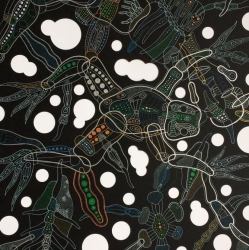
Art Gallery "KultProekt" is trying to explore the theme “From Abstraction to Symbol” by exhibiting graphic works of several Russian artists. Geometric figures and graphemes - a basic unit of the alphabet that could be either a letter or a hieroglyph - are explored as basic forms. The viewer is discovering the symbol during the moments of reflection.
“For me, the context with Russian constructivists is important as a unity of experimental search of the visual language based on construction, structure and space, rather than in terms of “tradition”. The images are shaping due to the structures of lines, colored spots and vibration of the small elements” – wrote Victor Lukin in his notes. He appeals to the works of Velimir Khlebnikov, whose creations also inspired the famous German artist Anselm Kiefer. The projects of Viktor Lukin are based on ideas of both Russian constructivists and reformer poets of the early 20th century.
Musical theme in the works of Vasily Vlasov was inspired by the famous Russian composer Alfred Schnittke and refers the viewer to the musical signs as a special type of the alphabet. The endless combinations of musical notes transform into bright suites on the artist’s canvas. In his works, the audience can notice the influence of Vasiliy Kandinsky, who also saw the forceful nature of sound behind the line.
While looking at works of Mikhail Molochnikov, the audience can meditatively immerse into the art, as if they were reading Buddhist mantras. In his works organic shapes have both symbolic and fractal meanings, imbued with bright energy. His works are partly decorative and refer to the works of Russian artists of the 20th century. They are associated with the “Russian seasons” by Sergei Diaghilev. Diversity of shapes and the colorfulness and brightness of Mikhail’s works refer us to the creations of Leon Bakst and the choreography of Vaclav Nijinsky in the ballet “The Afternoon Rest of the Faun”.
Artists inherit the traditions of the masters, introducing their own innovations, thereby preserving and updating the accumulated cultural values. Thus, there is a translation of meanings, symbolic codes, heritage and the expansion of collective cultural memory’s boundaries.
15.05 - 02.06.2019
